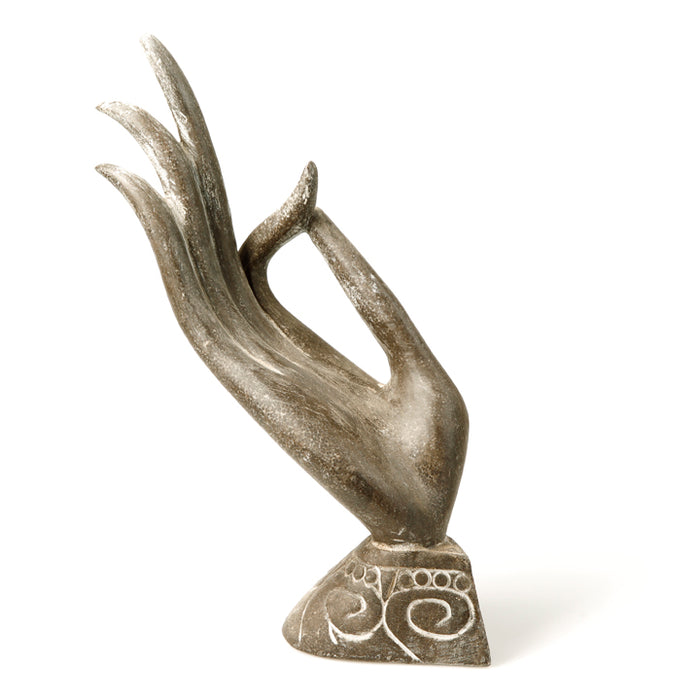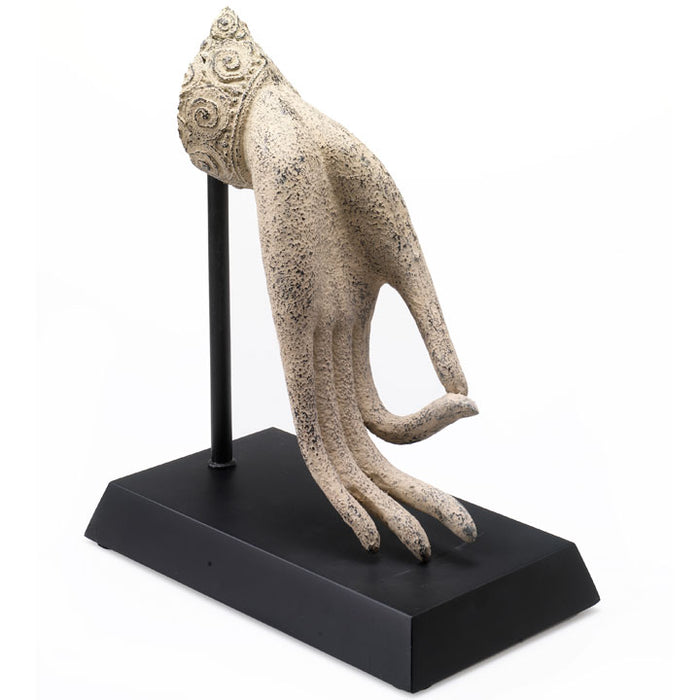
Buddha Statue Hands
In the calm and serene world of Buddhist art, the Buddha statue is a symbol of peace, enlightenment, and spiritual introspection. Across diverse cultures, these statues have not just been revered for their religious significance but also admired for their artistic brilliance. Among the various aspects of a Buddha statue, the hands—often positioned in graceful, symbolic gestures—hold a special place. They are not just artistic expressions but portray deep meanings, each telling a story of wisdom, compassion, or enlightenment.
While the materials used in crafting these statues, such as stone and wood, add to their aesthetic and spiritual presence, they also reflect the cultural contexts and artistic traditions of their origins. Stone Buddha statues, with their enduring and timeless appeal, have been a cornerstone in Buddhist art. Wooden Buddha statues, on the other hand, bring a touch of organic warmth and intricate craftsmanship.

Large Buddha statues, towering in majestic size, have become landmarks of spiritual and cultural significance around the world. These colossal representations are not just awe-inspiring in their scale but also in their artistic and spiritual interpretations. On the other side of the spectrum, Chinese Buddha statues, with their unique stylistic features and historical legacy, offer a glimpse into the rich tapestry of Buddhist art in China.
Here at Shimu we offer a wide range of beautiful Bhudda statues, including Chinese Buddha figures and Buddha statue hands. In this article we’ll explore the fascinating world of Buddha statue hands, looking at their historical significance, artistic beauty, and the symbolism behind each gesture. We’ll also give an overview of the various materials and sizes, from the grand stone and wooden sculptures to the intricate hand gestures of Chinese Buddha statues, understanding their impact and relevance in contemporary society.
Historical Context and Significance of Buddha Statues
Evolution of Buddha Statues Over Time
The history of Buddha statues is as rich and varied as Buddhism itself. Originating in India, the birthplace of Buddhism, these statues have undergone a remarkable evolution over the centuries. Initially, the Buddha was represented by symbols like the Bodhi tree, a lotus, or a wheel, rather than in human form. It was not until the 1st century CE that the anthropomorphic representation of Buddha emerged, possibly influenced by Greek artistic traditions brought by Alexander the Great's conquests.
These early statues depicted the Buddha in a serene, meditative state, often in the lotus position, with a focus on simplicity and spiritual aura. As Buddhism spread to other parts of Asia, each culture imbued the Buddha statues with its unique artistic characteristics. The Gandhara school of art, for instance, presented the Buddha with Hellenistic features, while the Mathura school in India depicted him in a more robust, Indian style.
Cultural Impact
Buddha statues have played a pivotal role in the cultural and religious landscapes of many Asian countries. In places like Tibet, Sri Lanka, Myanmar, and Thailand, these statues are central to Buddhist worship and practices. Each region's statues exhibit unique traits – Tibetan Buddha statues often feature elaborate, colourful details, while Thai statues are known for their elongated features and graceful lines.
In China, where Buddhism arrived in the 1st century CE, the representations of Buddha took on distinct characteristics. Chinese Buddha statues often have a more serene and gentle expression, reflecting the East Asian aesthetic and philosophical influences. These statues not only serve as religious icons but also as cultural artefacts that tell stories of historical exchanges, artistic evolution, and spiritual beliefs.
The significance of Buddha statues transcends simple artistic representation. They are symbols of peace, reminders of the Buddha's teachings, and tools for meditation. For Buddhists and art enthusiasts alike, these statues are a source of inspiration and contemplation, bridging the gap between the physical and the spiritual.

Materials Used in Crafting Buddha Statues
Stone Buddha Statues
Stone has been a favoured material for Buddha statues for centuries, prized for its durability and majesty. From the grand carvings of the Bamiyan Buddhas in Afghanistan to the serene stone sculptures in Japanese gardens, stone Buddha statues have been an enduring testament to Buddhist art.
Types of Stone and Their Significance
- Granite: Known for its hardness and weather resistance, granite has been used for many outdoor Buddha statues.
- Marble: Marble, with its fine texture and lustre, is often chosen for indoor statues, reflecting elegance and purity.
- Sandstone: Commonly used in Southeast Asia, sandstone has a softer appearance and is easier to carve.
Stone statues are not merely religious symbols; they are also embodiments of the artistic heritage of their regions. The choice of stone often reflects the local geography, making each statue uniquely tied to its place of origin.
Wooden Buddha Statues
Wood, with its natural warmth and versatility, offers a different aesthetic for Buddha statues. Wooden Buddha statues are often found in homes and temples, bringing a sense of tranquillity and organic beauty.
Crafting Techniques and Cultural Relevance
- Carving: Skilled artisans hand-carve intricate details, making each wooden statue unique.
- Polishing: The wood is often polished to a smooth finish, highlighting its natural grain and colour.
- Lacquering: Some traditions involve lacquering the wood, adding a protective layer and a subtle sheen.
Wooden Buddha statues are particularly popular in East Asia, including China and Japan, where woodcraft has a long and esteemed history. The use of wood also symbolises the Buddhist principle of impermanence, as wood changes over time, reminding us of the transient nature of life.

The Artistry of Buddha Statue Hands
The hands of Buddha statues, known as mudras, are a focal point of their artistry and symbolism. Each gesture carries a specific meaning, reflecting the teachings and moments in the life of the Buddha.
Symbolism of Hand Gestures
Common Mudras and Their Meanings
- Abhaya Mudra: The gesture of fearlessness, often depicted with the right hand raised. It symbolizes protection, peace, and the dispelling of fear.
- Dhyana Mudra: The meditation gesture, where hands are placed in the lap, palms upward. It represents the state of deep meditation and the attainment of spiritual perfection.
- Varada Mudra: The gesture of granting wishes or charity, shown with the palm facing outward and fingers pointing down. It symbolizes compassion and generosity.
These mudras are not just artistic choices; they are rich in symbolic meaning, offering insight into Buddhist philosophy and the Buddha's teachings.
Techniques in Sculpting Hands
The creation of Buddha hands requires not only artistic skill but also a deep understanding of their spiritual significance. Artisans often follow traditional methods, passed down through generations, to capture the essence of each gesture.

Key Aspects in Crafting Buddha Hands
- Proportion and Balance: The hands must be in proportion to the rest of the statue, maintaining a sense of balance and harmony.
- Detail and Precision: Every finger position is crafted with precision, as even a slight variation can change the mudra's meaning.
- Expression of Serenity: Regardless of the gesture, the hands of Buddha statues typically exude a sense of calm and serenity, reflecting the Buddha's enlightened state.
The hands of Buddha statues are more than just sculpted stone or wood; they are a conduit for conveying spiritual messages and teachings. Through these silent yet powerful gestures, the statues communicate the profound depths of Buddhist philosophy and the Buddha’s path to enlightenment.
Create a serene home with Buddha statue hands
The enduring appeal of Buddha statue hands and figures, transcending time and geographical boundaries, reflects the timeless relevance of their messages. They stand not only as objects of aesthetic appeal but as symbols of peace and wisdom in an ever-changing world. The silent language of their hands continues to inspire and guide seekers of spirituality, art enthusiasts, and those who find solace in their serene presence.
Our collection of buddha statue hands and figures is available to buy online, with convenient delivery direct to your door. If you would like to find out more about our products, please don’t hesitate to get in touch to speak to one of our team. Alternatively, why not visit our light and airy showroom which is located in Albion Mills, Greengates, West Yorkshire?
Nkuku Throws | Chinese Wood Panel | Chinese Wardrobes | Chinese Wardrobe Cabinet | Chinese Wall Art | Oriental Trunk | Oriental Stoneware | Chinese Storage Chests | Chinese Antique Dealers London | Stone Tang Horses | Wooden Buddha Statues | Apothecary Cabinet | Camphor Wood Chests | Chinese Tea Table | Antiques from China | Chinese Ceramics | Chinese Boxes | Oriental Mirror



